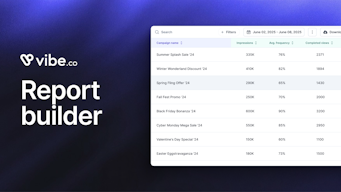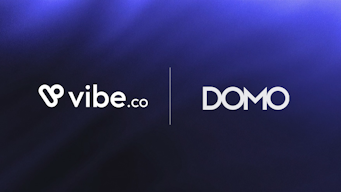7 Best The Trade Desk Competitors For Advertising
Finding the right programmatic advertising platform can feel like a challenge. Sure, The Trade Desk is a well-known option, but it might not be the perfect fit for everyone.
Are you looking for something more affordable, easier to use, or tailored to your specific needs?
Here’s what this blog covers:
- 7 best alternatives to The Trade Desk, like Vibe and StackAdapt.
- Strengths and weaknesses of each platform.
- How they compare to The Trade Desk.
- Which platform fits your goals and budget.
By the end, you’ll know which platform is best for your advertising needs. Let’s get started!
What Is The Trade Desk?
The Trade Desk is a tool that helps you run digital ads across websites, videos, audio, and connected TV (CTV).
It’s one of the most popular platforms for programmatic advertising, offering advanced tools to manage campaigns, target audiences, and track performance.
If you’re looking for a way to handle large-scale advertising with advanced tools, The Trade Desk is one of the most popular options out there.
What Are The Features of The Trade Desk?
Let’s have a look at some of the key features of The Trade Desk:
- Advertise Everywhere: You can manage campaigns across display, video, audio, and CTV all in one place.
- AI-Powered Optimization: The platform uses AI to help you make smarter decisions and improve your ad performance automatically.
- Detailed Reporting: With advanced reporting tools, you can measure how your campaigns are performing and find ways to improve.
- Advanced Targeting: You can create custom audiences, retarget people who’ve interacted with your brand, and focus on the right users.
- Global Reach: The platform helps you reach audiences worldwide, giving you access to a massive inventory of ad spaces.
While The Trade Desk is powerful and widely used, it doesn’t work perfectly for every business. Depending on your budget, experience, or goals, you might face some challenges using it.
Why Look for The Trade Desk Competitors?
Even though The Trade Desk is popular, many users have reported issues that can make it hard to use effectively:
- High Costs: Users often mention that the cost is too high, especially for small businesses or teams with tight budgets. Alternatives cater to businesses with smaller budgets, offering flexible pricing structures like pay-as-you-go plans or budget-friendly tiers.

- Steep Learning Curve: Advertisers report that the platform isn’t beginner-friendly. It takes time to figure out the tools and set up campaigns properly.

- Slow Reporting: Many users have said it can take 10 to 40 minutes to generate a report, which slows them down when they need quick insights.
- Limited Bulk Editing: If you’re managing multiple campaigns, making changes can feel tedious. Users say the lack of efficient bulk editing options is frustrating.

- Transparency Issues: Some users feel unsure about the exact costs and margins involved, which makes it harder to budget campaigns effectively.
- Broader Capabilities: While The Trade Desk is excellent for programmatic advertising, other platforms may offer additional tools like creative automation, advanced analytics, or niche channel integrations.
In short, The Trade Desk is a strong platform with advanced tools, but its high cost, complexity, and reporting delays make it less ideal for some businesses.
If these issues sound familiar, it might be time to explore other options.
Let’s take a closer look at the top alternatives and see how they compare.
The Trade Desk vs. Top 7 Competitors: Quick Comparison
| Platform | Key Features | Ideal Use Cases | Pricing Details |
|---|---|---|---|
| The Trade Desk | Omnichannel reach, AI-driven optimization, advanced targeting, detailed reporting | Large enterprises seeking comprehensive programmatic solutions | Custom pricing; contact for details. |
| Vibe | Multi-channel reach, real-time tracking, quick setup | Businesses of all sizes seeking budget-friendly CTV campaigns with ease of use | Cost-per-view starts at $0.02. |
| TVScientific | Performance-driven CTV advertising, integrations | Large businesses with significant budgets and data-driven goals | Flexible; contact for details. |
| Mountain | Self-serve platform, transparent reporting | Businesses focused on U.S. campaigns and ROI tracking | High CPM-based pricing; contact for details. |
| StackAdapt | Multi-channel advertising, AI-driven optimization | Agencies managing complex, multi-channel campaigns | Flexible; contact for details. |
| Simpli.fi | Granular household-level targeting, cross-channel reach | Businesses needing precise audience segmentation and reporting tools | Flexible; contact for details. |
| DV360 (Google Marketing Platform) | Integration with Google ecosystem, advanced analytics, vast inventory access | Enterprises requiring comprehensive digital marketing solutions | Custom pricing; contact for details. |
| Amazon DSP | Access to Amazon shopper data, e-commerce focus | E-commerce brands aiming to leverage Amazon's audience | Requires significant ad spend to access; contact for details. |
Note: Pricing details are subject to change; please refer to the respective platforms sections and more from their official websites for the most current information.
1. Vibe: Best DSP for Modern Advertising
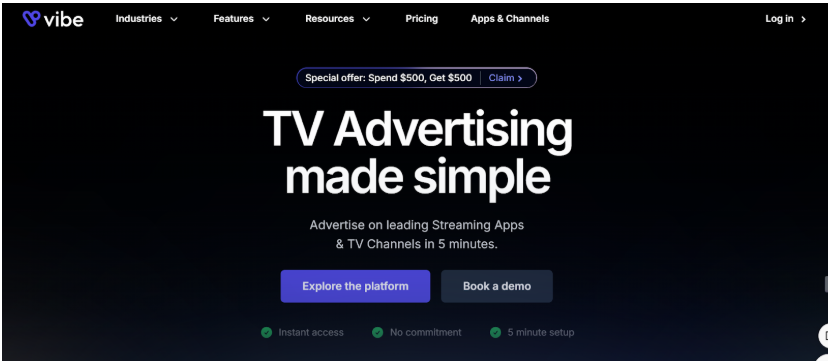
Vibe is a platform that helps you create and manage TV ads on streaming apps and channels. It's designed to be easy to use, so you can set up your ads quickly without any long-term commitments.
Unlike The Trade Desk, which can be complex and costly, Vibe offers a simpler interface and transparent pricing, making it accessible for businesses of all sizes.
Key Features of Vibe.co
Let’s explore some of the standout features that make Vibe a favorite for advertisers:
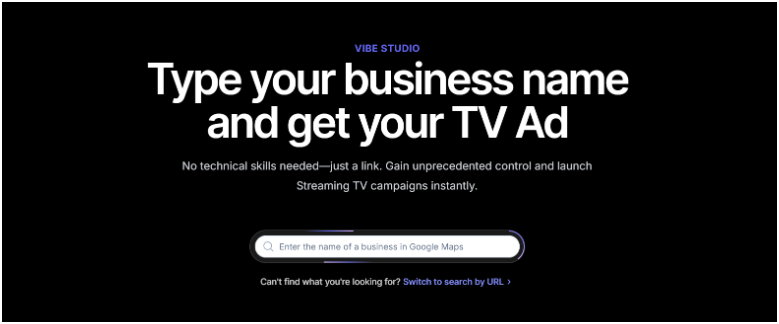
- Vibe Studio for Easy Ad Creation: Vibe Studio makes creating video ads simple and accessible. You can use its drag-and-drop tools to design high-quality, professional-looking ads without needing a dedicated creative team. And the best part is, it’s completely free!
- Efficient Performance Tracking: With Vibe, you can see how your ads are performing as they run. This helps you make changes on the spot, so you’re always in control.
- Audience Targeting Made Easy: Vibe lets you target specific groups of people based on their interests, location, and behavior. This ensures your ads reach the right audience without wasting your budget.
- Cross-Platform Insights: The platform provides detailed insights across different streaming apps and channels. This helps you understand which platforms are driving the best results so you can refine your strategy.
Pros and Cons of Vibe:
Now, let’s have a look at the pros and cons of Vibe:
Pros of Vibe:
- Simple and User-Friendly Interface: Unlike The Trade Desk, which many users find complex, Vibe is easy to navigate. You can set up and manage campaigns without needing extensive training.

- Transparent Pricing: Vibe has no hidden fees, and campaigns start at just $50 per day. The Trade Desk often has unclear pricing structures, making budgeting more challenging.
- Quick Reporting: While The Trade Desk users report delays in generating reports, Vibe’s reporting features are faster and easier to access, helping you make decisions in real-time.
Cons of Vibe:
- Complexity: Despite its user-friendly design, some users still find certain aspects of the platform complex, indicating a learning curve for new users.
- Filtering Issues: Users have reported difficulties with filtering options, suggesting that the platform's filtering capabilities could be improved for better campaign management.
Vibe.co Pricing
Vibe.co ensures its transparent pricing model, making it easy for businesses to plan their advertising budgets without worrying about hidden fees.

Here’s a detailed breakdown of Vibe.co’s pricing structure:
| Pricing Component | Details |
|---|---|
| Daily Budget | Start campaigns with a minimum of $50 per day. |
| Lifetime Budget | Allocate a lifetime budget starting at $500. |
| CPM (Cost Per Mille) | Rates range from $15 to $25, depending on targeting and platform. |
| Hidden Fees | None. Vibe operates with full transparency. |
This pricing structure makes Vibe accessible to small and medium businesses while offering promotional value for larger ad campaigns.
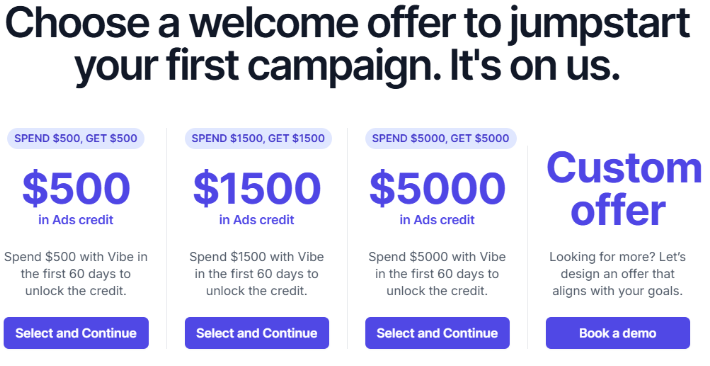
For the most accurate and up-to-date information, visit Vibe.co Pricing.
Vibe vs. The Trade Desk
| Metric | Vibe | The Trade Desk |
|---|---|---|
| Ease of Use | Intuitive and beginner-friendly | Complex and requires a steep learning curve |
| Pricing | Transparent; starts at $50/day | Custom pricing; often expensive for smaller budgets |
| Scalability | Designed for SMBs | Highly scalable for large campaigns |
| Ad Creation | Built-in Vibe Studio for creating video ads | Requires external creative resources |
| Real-Time Reporting | Quick and accessible | Report generation can be slow |
| Advanced Targeting | Yes | Yes |
| Supported Channels | Streaming apps and connected TV | Multiple channels, including display, video, audio, and CTV |
Vibe is an excellent option for businesses looking for a simpler and more affordable advertising solution.
With its clear pricing and fast performance, Vibe outshines The Trade Desk for advertisers seeking simplicity without sacrificing results.
2. TVScientific: Best for Video and OTT Advertising
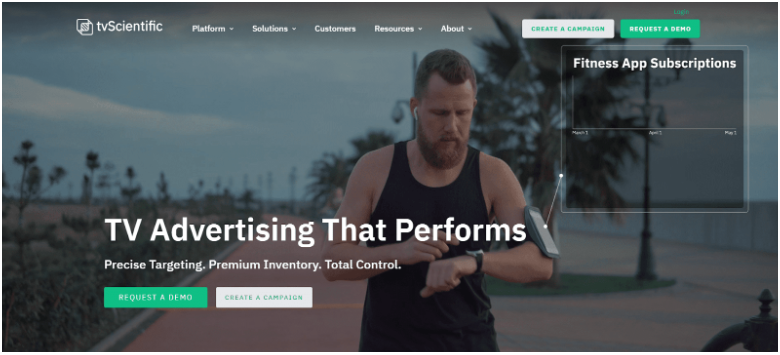
TVScientific is a platform designed for businesses to run targeted TV ads on streaming apps and OTT channels.
Unlike The Trade Desk, which caters to multi-channel advertising and can feel complex and expensive for smaller businesses, TVScientific specializes in video and OTT advertising.
Its advanced attribution models and user-friendly design make it a cost-effective and straightforward choice for advertisers focusing on video campaigns.
Key Features of TVScientific
TVScientific stands out for its specialized features that simplify and optimize video and OTT advertising. Here’s what makes it unique:
- Advanced Video Analytics: TVScientific provides in-depth insights into how your video ads perform, helping you understand viewer engagement and optimize campaigns accordingly.
- OTT Targeting: The platform enables precise audience targeting on OTT platforms, ensuring your ads connect with the right viewers.
- Monitor Your Reports: TVScientific allows you to monitor campaign performance live, so you can make adjustments on the go to maximize results.
- Attribution Models: Its robust attribution models help measure ROI by showing the direct impact of video ads on customer actions.
Pros and Cons of TVScientific
TVScientific offers several strengths, but like any platform, it has areas for improvement:
Pros of TVScientific:
- Advanced Audience Targeting: TVScientific ensures your ads reach the right viewers at the right time, enhancing campaign effectiveness.
- 24/7 Support: The platform offers continuous support, assisting users whenever needed.
Cons of TVScientific:
- High Minimum Spend: TVScientific does not disclose detailed pricing information publicly. This lack of transparency may make it challenging for advertisers, especially smaller businesses, to determine upfront whether the platform fits their budget.
- Integration Challenges: TVScientific may not integrate as seamlessly with some third-party tools or platforms compared to larger, more established DSPs. This could require additional effort for advertisers using specific tech stacks.
TVScientific Pricing
TVScientific does not publicly disclose detailed pricing information on its official website.
For accurate and up-to-date pricing details, it’s recommended to contact their team directly via their official website.
TVScientific vs. The Trade Desk
| Metric | TVScientific | The Trade Desk |
|---|---|---|
| Focus Area | Video and OTT advertising | Multi-channel advertising |
| Ease of Use | User-friendly and intuitive | Requires a learning curve |
| Attribution Models | Advanced models for video ROI | Standard attribution models |
| Multi-Channel Support | Limited | Extensive |
| Real-Time Reporting | Yes | Yes |
| Pricing | Custom pricing | Custom pricing; often expensive for smaller budgets |
TVScientific is a strong alternative to The Trade Desk for businesses that prioritize video and OTT advertising.
Its specialized features, clear attribution models, and ease of use make it a preferred choice for video-focused advertisers seeking simplicity and effectiveness.
3. Mountain: Performance-Driven CTV Advertising
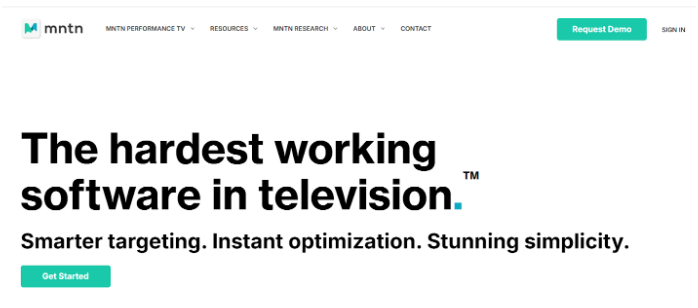
Mountain (MNTN) is a performance-focused Connected TV (CTV) advertising platform that helps businesses run targeted TV campaigns on streaming services.
Unlike The Trade Desk, which caters to multiple advertising channels, Mountain focuses exclusively on CTV, making TV advertising more accessible and measurable for brands of all sizes.
Key Features of Mountain
Mountain offers a suite of tools that simplify and optimize CTV advertising. Here’s what stands out:
- Creative Flexibility: Mountain allows you to create and manage ads with ease. Its tools are designed to give you creative freedom while ensuring campaigns align with brand goals.
- Performance Insights: With detailed analytics, you can track how your campaigns are performing and make data-driven adjustments to achieve better results.
- User-Friendly Platform: Mountain’s intuitive interface makes it easy for businesses, even those new to TV advertising, to set up and manage campaigns efficiently.
Pros and Cons of Mountain
Pros of Mountain:
- Great for CTV Campaigns: Mountain’s specialization in CTV ensures campaigns are optimized for TV audiences, delivering high performance.

- Measurable Results: Advertisers benefit from clear insights into campaign performance, making ROI tracking easier.
Cons of Mountain:
- Narrow Focus on TV: Mountain does not support multi-channel campaigns, which might be a limitation for businesses looking to advertise across platforms.

- Limited International Reach: Some users report that MNTN’s platform primarily focuses on the US market, making it less suitable for advertisers aiming to reach global audiences.
Mountain Pricing
Mountain does not publicly disclose detailed pricing information on its official website.
For accurate and personalized pricing details tailored to your campaign needs, it’s recommended to contact Mountain directly through their official website.
Mountain vs. The Trade Desk
| Metric | Mountain (MNTN) | The Trade Desk |
|---|---|---|
| Focus Area | Connected TV (CTV) advertising | Multi-channel advertising |
| Ease of Use | User-friendly and intuitive | Requires a learning curve |
| Performance Tracking | Advanced real-time insights | Comprehensive analytics across channels |
| Creative Flexibility | Tools for easy ad creation and management | Requires external creative resources |
| Pricing | Transparent, tailored to TV campaigns | Custom pricing; can be expensive for smaller budgets |
Mountain is an excellent choice for businesses prioritizing performance-driven CTV advertising.
Its user-friendly design, creative flexibility, and advanced analytics make it a strong alternative to The Trade Desk for TV-focused campaigns.
4. StackAdapt: A Versatile Multi-Channel DSP
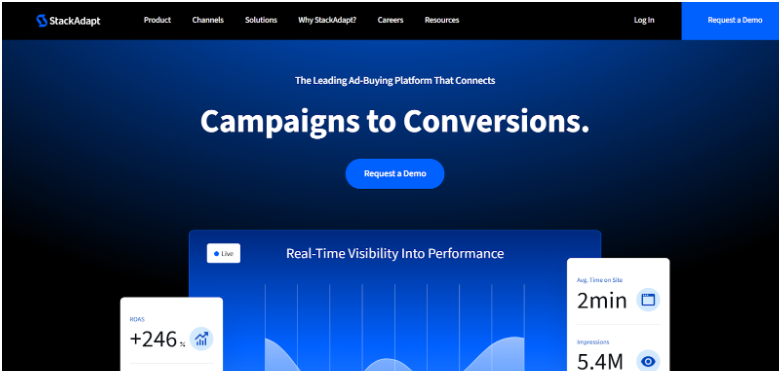
StackAdapt is a demand-side platform (DSP) that helps you manage advertising campaigns across various channels, such as native, display, video, connected TV, audio, and digital out-of-home.
Known for its AI-driven optimization and user-friendly design, StackAdapt simplifies campaign management and delivers efficient results.
Compared to The Trade Desk, StackAdapt focuses on versatile multi-channel support and ease of use, making it a better option for advertisers seeking simplicity.
In contrast, The Trade Desk offers more advanced features, catering to experienced advertisers but with a steeper learning curve.
Key Features of StackAdapt
Here’s what makes StackAdapt stand out:
- Multi-Channel Support: StackAdapt enables you to run campaigns across various channels, including native, display, video, and connected TV. This versatility allows you to reach your audience wherever they are.
- Native Advertising: StackAdapt specializes in native ads that blend seamlessly with content, helping you achieve higher engagement rates.
- AI-Driven Optimization: The platform uses machine learning to analyze past campaigns and optimize performance in real-time, ensuring your budget is spent effectively.
Pros and Cons of StackAdapt
StackAdapt has several strengths, but like any platform, it’s not without limitations.
Pros of StackAdapt:
- Versatility: StackAdapt supports campaigns across multiple channels, making it suitable for diverse advertising strategies.

- Ease of Use: Many users praise StackAdapt’s intuitive interface, which simplifies campaign setup and management.
Cons of StackAdapt:
- Learning Curve: Fully utilizing StackAdapt’s advanced features may take time, especially for first-time users.

- Limited Advanced Reporting Tools: Users report that StackAdapt’s reporting tools could be more advanced, particularly in connecting campaign performance to key business goals like lead generation.
StackAdapt Pricing
StackAdapt offers a flexible structure catering to businesses of all sizes.
While specific pricing details are not publicly disclosed, some sources suggest that monthly costs start at approximately $500 for a single user, scaling up to $4,000 for ten users, and reaching $30,000 for one hundred users.
For the most accurate and up-to-date information, it's recommended to contact StackAdapt directly to obtain a customized quote based on your specific needs.
StackAdapt vs. The Trade Desk
| Metric | StackAdapt | The Trade Desk |
|---|---|---|
| Multi-Channel Support | Yes | Yes |
| AI Optimization | Yes | Yes |
| User Interface | User-friendly | Requires a learning curve |
| Native Advertising | Specialized support | Standard support |
| Pricing | Custom pricing | Custom pricing; may be higher for smaller budgets |
StackAdapt is a versatile DSP designed for advertisers looking to manage multi-channel campaigns with ease.
Its AI-driven optimization, native ad expertise, and user-friendly design make it a compelling alternative to The Trade Desk for businesses seeking simplicity and effectiveness.
5. Simpli.fi: Best for Localized Advertising
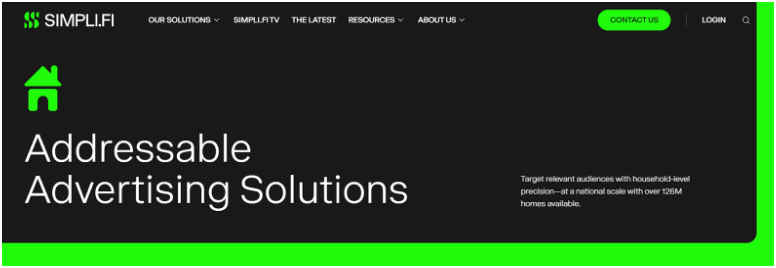
Simpli.fi is a leading advertising success platform that provides programmatic advertising solutions and workflow software to over 2,000 media teams, agencies, and brands.
When comparing Simpli.fi to The Trade Desk, reviewers have noted that Simpli.fi is easier to use, set up, and administer.
Additionally, Simpli.fi is preferred for ongoing product support and meets business needs more effectively.
Key Features of Simpli.fi
- Geo-Fencing: Simpli.fi's platform includes geo-fencing capabilities, allowing advertisers to target audiences within specific geographic boundaries.
- Localized Programmatic Advertising: The platform empowers advertisers to maximize relevance in their campaigns, delivering results across various media types, including CTV, mobile, and display.
- Dynamic Creative Optimization (DCO): Simpli.fi offers solutions that enhance efficiencies in digital media buying, including ad creative generation and campaign planning.
Pros and Cons of Simpli.fi
Pros of Simpli.fi:
- Ease of Use: Users have found Simpli.fi to be user-friendly, making it easier to set up and manage campaigns compared to other platforms.

- Effective Customer Support: Reviewers have expressed a preference for Simpli.fi's ongoing product support, indicating a positive experience with their customer service.
Cons of Simpli.fi:
- Limited Advanced Reporting Features: Some users have expressed a desire for more advanced reporting and analytics tools that directly connect campaign results to key business objectives, such as lead generation.

- Integration Challenges: A few users have noted difficulties in integrating Simpli.fi with other marketing tools and platforms. These challenges can lead to inefficiencies and require additional manual work to synchronize data across systems.
Simpli.fi Pricing
Simpli.fi does not publicly disclose specific pricing details.
For tailored pricing options based on your campaign’s size and scope, it’s recommended to contact Simpli.fi directly through their official website.
Simpli.fi vs. The Trade Desk
In summary, Simpli.fi is a robust platform for localized advertising, offering user-friendly features and effective customer support.
| Metric | Simpli.fi | The Trade Desk |
|---|---|---|
| Ease of Use | User-friendly and easy to set up | Requires a learning curve |
| Customer Support | Preferred by users for ongoing support | Standard support |
| Feature Updates | Users desire more frequent updates | Regular feature updates |
| Internationalization | Supports multiple languages and currencies | Extensive global reach |
While it may have some limitations in internationalization and feature updates.
Its strengths in geo-fencing and localized programmatic advertising make it a compelling choice for regional campaigns.
6. Google Marketing Platform (DV360): A Heavyweight DSP
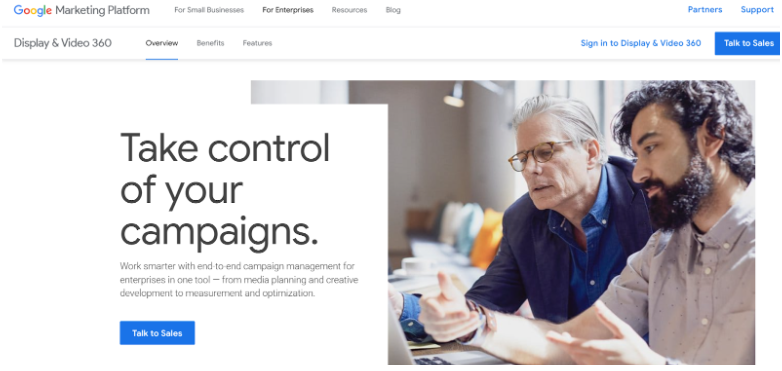
Google Display & Video 360 (DV360) is a demand-side platform (DSP) that helps you run ads across display, video, TV, and audio.
It integrates seamlessly with Google’s ecosystem, offering advanced analytics and access to Google’s vast ad inventory.
While it provides powerful tools and works well for businesses using Google Ads, DV360’s complexity and higher costs can make it less suitable for smaller businesses compared to The Trade Desk.
Key Features of DV360
- Comprehensive Campaign Management: DV360 allows you to design, plan, and optimize campaigns across multiple channels, making campaign management more efficient.
- Advanced Audience Insights: The platform provides detailed data about audience behavior to help you target your ads effectively.
- Google Ads Integration: Its close connection with Google Ads ensures streamlined workflows and comprehensive reporting.
Pros and Cons of Google DV360
Pros of Google DV360:
- Enterprise Capabilities: DV360's comprehensive features cater to large-scale campaigns, offering tools suitable for enterprise needs.

- Extensive Audience Reach: Users mention that Google DV360 is an excellent tool for reaching a broad audience, especially for top-of-the-funnel marketing campaigns.
Cons of Google DV360:
- Higher Costs: The platform's advanced capabilities may come with higher costs, which could be a consideration for smaller businesses.

- Complexity in Campaign Setup: Users mention that setting up new campaigns in DV360 can be complicated, involving multiple steps and intricate details. For example, some users note challenges in creating smart display or dynamic remarketing campaigns due to eligibility restrictions, which adds to the platform's complexity.
Google DV360 Pricing
DV360 offers custom pricing tailored to the specific needs and scale of your campaigns.
For detailed pricing information, it's recommended to contact Google's sales team or an authorized reseller.
Google DV360 vs. The Trade Desk
| Metric | DV360 | The Trade Desk |
|---|---|---|
| Integration | Seamless with Google ecosystem | Integrates with various third-party platforms |
| Analytics | Advanced analytics with Google data | Robust analytics capabilities |
| Learning Curve | Steeper learning curve | Moderate learning curve |
| Cost | Potentially higher costs | Variable pricing; may be more accessible for smaller budgets |
DV360 is a powerful choice if you need deep Google integration and advanced analytics.
However, its complexity and costs might make it better suited for larger businesses with the resources to fully utilize its capabilities.
7. Amazon Advertising (Amazon DSP): Best for E-Commerce Brands
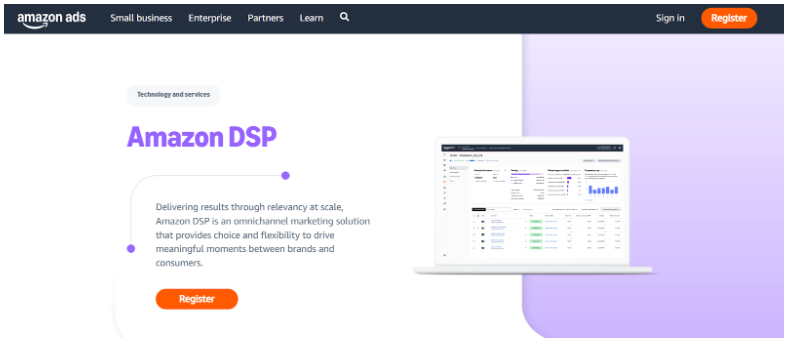
Amazon DSP is a platform designed to help you reach shoppers across Amazon’s websites, apps, and third-party platforms.
Built specifically for e-commerce, it gives you access to Amazon’s rich shopper data, allowing you to target the right audience based on their shopping habits.
Unlike The Trade Desk, which supports multi-channel campaigns, Amazon DSP focuses solely on e-commerce, giving you a significant edge in targeting and converting buyers.
While The Trade Desk offers more flexibility for non-retail campaigns, it lacks the specialized e-commerce insights that make Amazon DSP an ideal choice for businesses looking to drive online sales.
Key Features of Amazon DSP
Here are the key features of Amazon DSP:
- Shopper Data for Targeting: Amazon DSP lets you use real-time shopper behavior and demographics to target your ads. This ensures you’re reaching people who are ready to buy.
- Cross-Platform Reach: Your ads can appear not only on Amazon but also on other premium apps, websites, and devices, extending your reach beyond the platform.
- Detailed Reporting Tools: Amazon DSP offers in-depth reports that show you how your ads are performing. This data helps you make informed decisions and optimize your campaigns for better results.
Pros and Cons of Amazon DSP
Pros of Amazon DSP:

- Precise Targeting: Unlike The Trade Desk, Amazon DSP uses shopper data to deliver ads to the right audience, addressing one of the major drawbacks of broader platforms.
- E-Commerce Focus: If you sell products online, Amazon DSP’s tools are tailored to drive sales effectively.

- Broad Reach: You can advertise across Amazon and premium third-party networks, expanding your customer base.
Cons of Amazon DSP:
- Complex Platform: Some users mention that it takes time to setup and learn the platform’s advanced features.
- High Budget Requirements: Smaller advertisers may find the minimum spend a challenge to meet.
Amazon DSP Pricing
Amazon DSP does not publicly disclose specific pricing.
However, it typically requires a significant ad spend to access. If you’re interested in using the platform, you’ll need to contact Amazon’s sales team for detailed pricing and requirements.
Amazon DSP vs. The Trade Desk
| Metric | Amazon DSP | The Trade Desk |
|---|---|---|
| Integration | Deep with Amazon’s ecosystem | Supports various third-party integrations |
| Audience Targeting | Uses real-time Amazon shopper data | Broad targeting capabilities across channels |
| Learning Curve | Requires training and time | Moderate complexity |
| Cost | High minimum spend required | Custom pricing; better for smaller budgets |
Amazon DSP is a powerful platform for advertisers focused on e-commerce.
By tapping into Amazon’s shopper data and offering cross-platform reach, it helps you connect with the right audience and boost sales.
While it may not suit smaller budgets, it’s an excellent choice for brands looking to dominate the online retail space.
Which Trade Desk Competitor Should You Choose for Your Advertising Needs?
Now that we have explored each platform in detail, let’s see which competitor is the best fit for your advertising needs.
Whether you’re a small business, a video-focused advertiser, or an enterprise looking for advanced tools, this comparison will help you decide:
| Category | Platform | Why It’s the Best Choice |
|---|---|---|
| Best for SMBs | Vibe | Simple and affordable, with an intuitive interface perfect for small and medium-sized businesses. |
| Best for Video Campaigns | TVScientific | Specializes in OTT and video ads with advanced targeting and performance analytics. |
| Best for CTV Advertising | Vibe | Strong CTV capabilities, offering effective reach for connected TV campaigns. |
| Best for Local Advertising | Simpli.fi | Excels in geo-fencing and localized advertising, ideal for targeting regional audiences. |
| Best for Multi-Channel Campaigns | StackAdapt | Versatile platform supporting native, display, and video ads across multiple channels, powered by AI optimization. |
| Best for Enterprise Solutions | Vibe | Scalable solutions for large enterprises with advanced targeting and analytics. |
How Did We Choose These Trade Desk Competitors?
We selected these platforms based on key factors that matter to advertisers:
- Relevance to Business Needs: Platforms that cater to small businesses, enterprises, and niche advertisers like video or e-commerce.
- Core Features: Advanced targeting, multi-channel support, and user-friendly interfaces were prioritized.
- Cost-Effectiveness: Budget-friendly options with transparent pricing to address The Trade Desk’s high costs.
- Performance Metrics: Platforms offering real-time reporting, ROI tracking, and optimization tools for better results.
- Industry Strengths: Specialized solutions for CTV, OTT, e-commerce, and localized campaigns.
- User Feedback: Positive reviews for ease of use, support, and campaign management.
- Scalability: Flexibility to support businesses of all sizes, from small campaigns to enterprise-level needs.
These criteria helped us identify reliable and effective alternatives to The Trade Desk.
Conclusion
In this blog, we’ve explored the top alternatives to The Trade Desk, looking closely at their features, strengths, and ideal use cases.
From Vibe, known for its simplicity and cost-effectiveness, to Amazon DSP, a leader in e-commerce targeting, and DV360, an enterprise powerhouse, each platform offers unique benefits tailored to different needs.
Here’s the bottom line:
- If you’re a small or medium-sized business, Vibe stands out as the most accessible and user-friendly choice.
- For e-commerce brands, Amazon DSP delivers precise targeting using shopper insights.
- Enterprises or those needing advanced multi-channel capabilities might find DV360 or The Trade Desk more suitable.
Overall Vibe truly shines across the board for its balance of affordability, ease of use, and powerful features.
Unlike other platforms that can feel overwhelming or overly complex, Vibe makes advertising simple, transparent, and effective.
Whether you’re new to digital advertising or looking for a platform that adapts to your growing business needs, Vibe offers the perfect combination of sophistication and simplicity.
So why wait? Visit Vibe.co today, and see how it can help you run campaigns that deliver real results.
Make the smart move now!
FAQs About The Trade Desk Competitors
1. Who are the main competitors to The Trade Desk?
Top competitors include Vibe, TVScientific, Mountain, Simpli.fi, StackAdapt, Google DV360, and Amazon DSP, each catering to different advertising needs such as video, CTV, local, and e-commerce campaigns.
2. How does Vibe compare to The Trade Desk?
Vibe is simpler, more affordable, and user-friendly, making it ideal for SMBs, whereas The Trade Desk suits enterprises with advanced multi-channel capabilities.
3. What is the best option for video-focused advertising?
TVScientific is the best choice for video and OTT campaigns, offering advanced targeting and analytics for video-first advertisers.
4. Which platform is ideal for localized campaigns?
Simpli.fi excels at geo-fencing and localized programmatic advertising, making it perfect for regional targeting.
5. What’s the best advertising platform for e-commerce brands?
Amazon DSP is unmatched for e-commerce, leveraging Amazon’s shopper data for precise audience targeting and measurable sales results.

